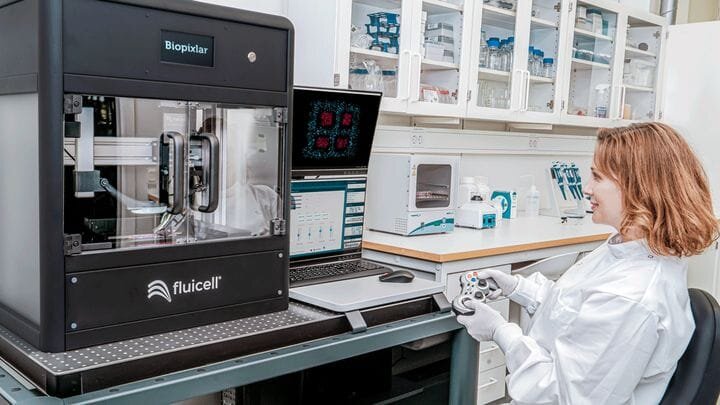![Tech operates the Biopixlar bioprinter [Source: Fluicell]](https://fabbaloo.com/wp-content/uploads/2020/05/image-asset_img_5eb08d02dab25.jpg)
Fluicell is a Swedish biotech company that’s developed a unique 3D printing process for living cells with their new device, the Biopixlar.
The normal method of 3D printing living cells with typical bioprinters of today uses a syringe-like mechanism to deposit cell material within a gel or scaffold structure. The gel or scaffold provides a means to maintain the desired 3D shape during and after printing.
This is because cells do not naturally adhere to each other; if you simply 3D printed cells, you’d quickly end up with an amorphous blob, gradually spreading out on your build platform. Thus, bioprinters typically use scaffolds or gels to hold things together.
However, over time the cells do bind together as they multiple and grow into the desired final shape. Gels can be washed away, while scaffolds are usually designed to slowly dissolve at the same rate as the cells can grow into target geometries.
Fluicell 3D Printing Process
![Individual cell bioprinting process [Source: Fluicell]](https://fabbaloo.com/wp-content/uploads/2020/05/Biopixlar-3D-illustration-1024x576_img_5eb08d032e48e.jpg)
Now Fluicell has a new idea for cell 3D printing. It’s likely derived from their substantial experience in the field, having been founded in 2012. Thus far they have developed several biotech hardware items, including a BioPen for delivering precision quantities of drugs to individual cells, or an ion channel screening platform.
Now their new Biopixlar bioprinting system could change things in the bioprinting market.
Their tagline for the product is “Print Tissue As Nature Intended”, and that seems to be more-or-less exactly what happens in Biopixlar. The goal of the system is to produce “human-like tissues” for drug testing, producing replica tissue, understanding diseases and similar applications. It does not appear their technology is, at least at the moment, designed for human transplantation.
![BIoprinted human cancer model for study [Source: Fluicell]](https://fabbaloo.com/wp-content/uploads/2020/05/image-asset_img_5eb08d0393723.jpg)
That said, there is extreme interest in these applications by laboratories worldwide. Constant research into all forms of human maladies requires test platforms, and that’s exactly what Biopixlar is designed to produce: tissues for testing and investigation.
Biopixlar Process
How does it work? The Biopixlar system begins with a delivery system that can deposit single cells with great accuracy. But the secret is that Fluicell has developed a mysterious compound that allows the cells to adhere to each other. This negates the need for use of gels or scaffolds entirely.
The result is that you can 3D print a tissue structure that is immediately complete and not have any concerns about dealing with gels or scaffolds.
Biopixlar Features
Fluicell lists some of the possible benefits and features of Biopixlar:
-
Single cell resolution
-
Design your biological tissue by printing down to the level of individual cells.
-
High-precision and reproducibility
-
Structure your biological tissue by precisely controlling the spatial deposition of your living cells and benefit from high reproducibility across replicates.
-
>95 % cell viability
-
The printing process is optimized to minimize the shear forces on the cell sample, achieving very high cell viability (cell viability was tested across multiple cell lines).
-
Multi-cellular models
-
Compose your biological tissue by printing up to three different cell types from the same printer head. By changing the printer head, new cell types can be printed.
-
Real-time monitoring
-
Follow your printing process in real-time with the fully integrated multi-color fluorescence imaging setup.
-
Ideal for valuable cell sources
-
Biopixlar is designed for handling scarce and valuable cell sources such as stem cells, primary cells and patient biopsies.
Gamepad on 3D Printer
One of the more curious innovations included with Biopixlar is a gamepad. No, really, a gamepad! You can see this in the image at top, where the technician is using the gamepad.
I believe this is the only 3D printer of any type that is equipped with a gamepad. The idea for this type of interface is that it allows the Biopixlar operator to manually guide the deposition of individual cells, as opposed to using a 3D model to drive the printing. Of course, there is an on-board microscope to assist in this process.
This capability could allow the Biopixlar to deposit new cells on an existing sample, for example. This widens the potential applications for the unusual bioprinter.
The bioprinter market currently does not offer gel-free printers, but Fluicell intends on changing that. However, they’ll have to explain their unusual approach to potential clients to secure sales of the unusual Biopixlar device.
Via Fluicell

